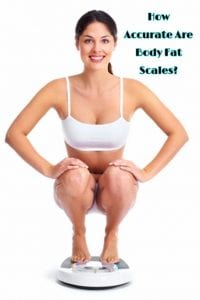 If you’re dieting and exercising to lose weight and improve your health and fitness, you may be wondering if it’s worth buying a body fat scale.
If you’re dieting and exercising to lose weight and improve your health and fitness, you may be wondering if it’s worth buying a body fat scale.
Sure, you can monitor your weight loss on a regular bathroom scale, but weight loss does not tell the entire story. You could lose a lot of weight but still have a high percentage of fat, which is unhealthy.
Knowing your body’s muscle to fat ratio is a more accurate indicator of your fitness and health. This being the case, a body fat scale can be very helpful.
Have you ever dieted and exercised and hopped onto the scale sure you’ve lost a few pounds, only to find the number on the scale hasn’t budged?
If so, it’s possible that you had, in fact, lost body fat and gained muscle, which weighs more than fat.
A body fat scale will tell you not only your weight but also your body fat percentage.
This article will answer the questions, how do body fat scales work, how accurate are body fat scales, and what is a healthy body fat percentage.
It will also cover how to use a body fat scale and the features to look for when buying one.
NB: If you have a pacemaker, check with your doctor before using this type of device, as its electrical current could negatively impact your health and well-being.
Body fat scales are considered unreliable for athletes, bodybuilders, and children.
Individuals with metal screws or plates in their bodies and pregnant women may also get inaccurate readings.
Table of Contents
How do they work?
When weighing yourself on a body fat scale, a harmless, low-level electrical current passes through your body by way of your feet. This is known as Bioelectrical Impedance Analysis or BIA.
Tissue containing a high percentage of water, such as muscle, allows the current to pass through quickly.
On the other hand, fat has little water, so it resists the current.
The higher the impedance, the more body fat you have.
A computer in the scale uses this information along with personal data you’ve entered, including your gender, age, height, and fitness level, to calculate your body fat percentage.
How accurate are they?
If you’re thinking of buying one, it’s natural you will want to know how accurate body fat scales are.
Many studies have been done on this very subject.
The reality is that, at best, this type of scale gives an estimate of body fat that is typically on the low side. Even the best body fat scales tend to give a reading that is around 3 to 4% off.
Factors including your body type, body temperature, whether or not you are well-hydrated, and when you last exercised can impact the reading, as can weighing yourself with wet or sweaty feet.
What is a healthy body fat percentage?
Before using a body fat scale, you will probably want to know what a healthy body fat percentage is.
Fat regulates our body temperature, cushions our organs and tissues, and is our primary form of energy storage. While too high a level is unhealthy, too low a level is also. The recommended range is higher for women than men, as adult females need more body fat to function well.
Healthy body fat percentages vary depending on the person’s gender, age, body type, and activity level. There are ways to calculate your ideal level manually, but it’s easier to key your details into your scale’s computer and follow the guidelines.
How do body fat scales work?
How to Use a Body Fat Scale
Regardless of the accuracy of the reading, if you stick to a routine when using it, a body fat scale is a useful tool for tracking your weight loss and fitness journey.
Do not use the scale on carpet. Place it on a tiled or wooden floor with an even surface in a room with a stable temperature.
Weigh yourself at approximately the same time, every time, and drink and eat roughly the same amount every weigh-in day.
Don’t weigh yourself immediately after you’ve eaten or within 24 hours of drinking a lot of alcohol or exercising excessively. Your fluid intake at such times will skew the reading.
Before stepping onto the scale, remove your shoes and make sure your feet are clean and dry to give them good contact with the scales’ sensor pads.
Features to look for in a body fat scale
- User-friendly
Look for a scale with easy-to-understand instructions and guidelines and simple-to-operate controls.
- Readout
Make sure the numbers on the scale are clear and large enough to read. If you are short-sighted, you may want to buy a model with a wireless display unit that attaches to a wall.
- Data
The information displayed should be easy to understand. It should also remain on the screen long enough for you to read it.
If possible, buy a scale that allows you to redisplay the data without having to weigh yourself a second time.
- Multiple user profiles
If you purchase a body fat scale with the facility to enter multiple user profiles, everyone in your household will be able to use it.
Some scales also have a “guest” profile option. This feature is useful if visiting friends or family members want to use the scale.
- Weight only option
If you choose a scale with a “weight only” setting, you will also be able to use the device as you would a regular bathroom scale.
Most body fat scales have this option. Check to see the model you are thinking of buying does.
- Additional features
Many body fat scales come with additional features including the ability to measure Body Mass Index (BMI).
Some scales also display goals based on the personal details you enter. For example, a weight to aim for, daily calorie intake, etc.
How to Use a Body Fat Scale Summary
Body fat scales are inexpensive and easy to use. This makes them a worthwhile investment for anyone who wants to monitor how well their diet and exercise program is working.
While the reading you get may not be spot-on, you can still use the information to track changes in your body fat level. This will enable you to make adjustments to your diet and exercise plans if need be and help you to achieve your goals.
You may also like to read, How Often Should You Weigh Yourself When Trying to Lose Weight?

